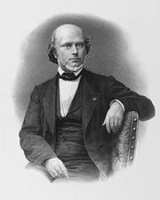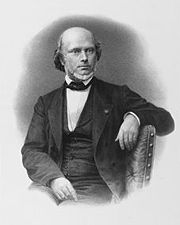
Jean Louis Armand de Quatrefages de Bréau
Encyclopedia
Jean Louis Armand de Quatrefages de Bréau (February 10, 1810 – January 12, 1892) was a French
naturalist
.

of Valleraugue
(Gard
), the son of a Protestant farmer. He studied medicine
at Strasbourg
, where he took the double degree of M.D. and D.Sc., one of his theses being a Théorie d'un coup de canon (November 1829); next year he published a book, Sur les arolithes, and in 1832 a treatise on L'Extraversion de la vessie. Moving to Toulouse
, he practised medicine for a short time, and contributed various memoirs to the local Journal de Médecine and to the Annales des sciences naturelles (1834–36). But being unable to continue his research in the provinces, he resigned the chair of zoology to which he had been appointed, and in 1839 settled in Paris
, where he found in Henri Milne-Edwards
a patron and a friend.
Elected professor of natural history at the Lycée Napoléon in 1850, he became a member of the French Academy of Sciences
in 1852, and in 1855 was appointed to the chair of anthropology and ethnography at the Museum National d'Histoire Naturelle
. Other distinctions followed rapidly, and continued to the end of his otherwise uneventful career, the more important being honorary member of the Royal Society of London (June 1879), member of the Institute and of the Academie de médecine, and commander of the Legion of Honor (1881). He died in Paris.
He was an accurate observer and unwearied collector of zoological materials, gifted with remarkable descriptive power, and possessed of a clear, vigorous style, but somewhat deficient in deep philosophic insight. Hence his serious studies on the anatomical characters of the lower and higher organisms, man included, will retain their value, while many of his theories and generalizations, especially in the department of ethnology, are already forgotten.
Then there is the vast series issued under the general title of Etudes sur les types inférieurs de l'embranchement des annelés, and the results of several scientific expeditions to the Atlantic and Mediterranean coastlands, Italy and Sicily, forming a series of articles in the Revue des deux mondes
, or embodied in the Souvenirs d'un naturaliste (2 vols., 1854).
These were followed in quick succession by the:
France
The French Republic , The French Republic , The French Republic , (commonly known as France , is a unitary semi-presidential republic in Western Europe with several overseas territories and islands located on other continents and in the Indian, Pacific, and Atlantic oceans. Metropolitan France...
naturalist
Natural history
Natural history is the scientific research of plants or animals, leaning more towards observational rather than experimental methods of study, and encompasses more research published in magazines than in academic journals. Grouped among the natural sciences, natural history is the systematic study...
.

Life
He was born at Berthézène, in the communeCommunes of France
The commune is the lowest level of administrative division in the French Republic. French communes are roughly equivalent to incorporated municipalities or villages in the United States or Gemeinden in Germany...
of Valleraugue
Valleraugue
Valleraugue is a commune in the Gard department in southern France.-Geography:Valleraugue is located in a deep valley of the Cévennes mountains, on the Hérault River.-Population:-Personalities:Valleraugue was the birthplace of:...
(Gard
Gard
Gard is a département located in southern France in the Languedoc-Roussillon region.The department is named after the River Gard, although the formerly Occitan name of the River Gard, Gardon, has been replacing the traditional French name in recent decades, even among French speakers.- History...
), the son of a Protestant farmer. He studied medicine
Medicine
Medicine is the science and art of healing. It encompasses a variety of health care practices evolved to maintain and restore health by the prevention and treatment of illness....
at Strasbourg
Strasbourg
Strasbourg is the capital and principal city of the Alsace region in eastern France and is the official seat of the European Parliament. Located close to the border with Germany, it is the capital of the Bas-Rhin département. The city and the region of Alsace are historically German-speaking,...
, where he took the double degree of M.D. and D.Sc., one of his theses being a Théorie d'un coup de canon (November 1829); next year he published a book, Sur les arolithes, and in 1832 a treatise on L'Extraversion de la vessie. Moving to Toulouse
Toulouse
Toulouse is a city in the Haute-Garonne department in southwestern FranceIt lies on the banks of the River Garonne, 590 km away from Paris and half-way between the Atlantic Ocean and the Mediterranean Sea...
, he practised medicine for a short time, and contributed various memoirs to the local Journal de Médecine and to the Annales des sciences naturelles (1834–36). But being unable to continue his research in the provinces, he resigned the chair of zoology to which he had been appointed, and in 1839 settled in Paris
Paris
Paris is the capital and largest city in France, situated on the river Seine, in northern France, at the heart of the Île-de-France region...
, where he found in Henri Milne-Edwards
Henri Milne-Edwards
Henri Milne-Edwards was an eminent French zoologist.Henri Milne-Edwards was the 27th child of William Edwards, an English planter and militia colonel in Jamaica and Elisabeth Vaux, a French. He was born in Bruges, Belgium, where his parents had retired. At that time, Bruges was a part of the...
a patron and a friend.
Elected professor of natural history at the Lycée Napoléon in 1850, he became a member of the French Academy of Sciences
French Academy of Sciences
The French Academy of Sciences is a learned society, founded in 1666 by Louis XIV at the suggestion of Jean-Baptiste Colbert, to encourage and protect the spirit of French scientific research...
in 1852, and in 1855 was appointed to the chair of anthropology and ethnography at the Museum National d'Histoire Naturelle
Muséum national d'histoire naturelle
The Muséum national d'Histoire naturelle is the National Museum of Natural History in Paris, France.- History :The museum was formally founded on 10 June 1793, during the French Revolution...
. Other distinctions followed rapidly, and continued to the end of his otherwise uneventful career, the more important being honorary member of the Royal Society of London (June 1879), member of the Institute and of the Academie de médecine, and commander of the Legion of Honor (1881). He died in Paris.
He was an accurate observer and unwearied collector of zoological materials, gifted with remarkable descriptive power, and possessed of a clear, vigorous style, but somewhat deficient in deep philosophic insight. Hence his serious studies on the anatomical characters of the lower and higher organisms, man included, will retain their value, while many of his theories and generalizations, especially in the department of ethnology, are already forgotten.
Works
The work of de Quatrefages ranged over the whole field of zoology from the annelids and other low organisms to the anthropoids and man. Of his numerous essays in scientific periodicals, the more important were:- Considérations sur les caractères zoologiques des rongeurs (1840)
- De l'organisation des animaux sans vertèbres des Côtes de la Manche (Ann. Sc. Nat., 1844)
- Recherches sur le système nerveux, l'embryognie, les organes des sens, et la circulation des annélides (Ibid., 1844–50)
- Sur les affinités et les analogies des lombricsEarthwormEarthworm is the common name for the largest members of Oligochaeta in the phylum Annelida. In classical systems they were placed in the order Opisthopora, on the basis of the male pores opening posterior to the female pores, even though the internal male segments are anterior to the female...
et des sangsuesLeechLeeches are segmented worms that belong to the phylum Annelida and comprise the subclass Hirudinea. Like other oligochaetes such as earthworms, leeches share a clitellum and are hermaphrodites. Nevertheless, they differ from other oligochaetes in significant ways...
(Ibid.) - Sur l'histoire naturelle des tarets (Ibid., 1848–49)
Then there is the vast series issued under the general title of Etudes sur les types inférieurs de l'embranchement des annelés, and the results of several scientific expeditions to the Atlantic and Mediterranean coastlands, Italy and Sicily, forming a series of articles in the Revue des deux mondes
Revue des deux mondes
The Revue des deux Mondes is a French language monthly literary and cultural affairs magazine that has been published in Paris since 1829....
, or embodied in the Souvenirs d'un naturaliste (2 vols., 1854).
These were followed in quick succession by the:
- Physiologie comparée, métamorphoses de l'homme et des animaux (1862)
- Les Polynésiens et leurs migrations (1866)
- Histoire naturelle des Annelés marins et d'eau douce (2 vols., 1866)
- La Rochelle et ses environs (1866)
- Rapport sur les progrés de l'anthropologie (1867)
- Charles DarwinCharles DarwinCharles Robert Darwin FRS was an English naturalist. He established that all species of life have descended over time from common ancestry, and proposed the scientific theory that this branching pattern of evolution resulted from a process that he called natural selection.He published his theory...
et ses précurseurs francais (1870), a study of evolution in which the writer takes somewhat the same attitude as Alfred Russel WallaceAlfred Russel WallaceAlfred Russel Wallace, OM, FRS was a British naturalist, explorer, geographer, anthropologist and biologist...
, combating the Darwinian doctrine in its application to man - La Race prussienne (1871)
- Crania Ethnica, jointly with Dr Hamy (2 vols., with 100 plates, 1875–82), a classical work based on French and foreign anthropological data, analogous to the Crania of Thurnam and Davis, and to S. G. Morton's Crania Americana and Crania Aegyptiaca
- L'Espèce humaine (1877)
- Nouvelles études sur la distribution géographique des NégritosNegritoThe Negrito are a class of several ethnic groups who inhabit isolated parts of Southeast Asia.Their current populations include 12 Andamanese peoples of the Andaman Islands, six Semang peoples of Malaysia, the Mani of Thailand, and the Aeta, Agta, Ati, and 30 other peoples of the Philippines....
(1882) - Hommes fossiles et hommes sauvages (1884)
- Histoire générale des races humaines (2 vols., 1886–89), the first volume being introductory, while the second attempts a complete classification of mankind.

